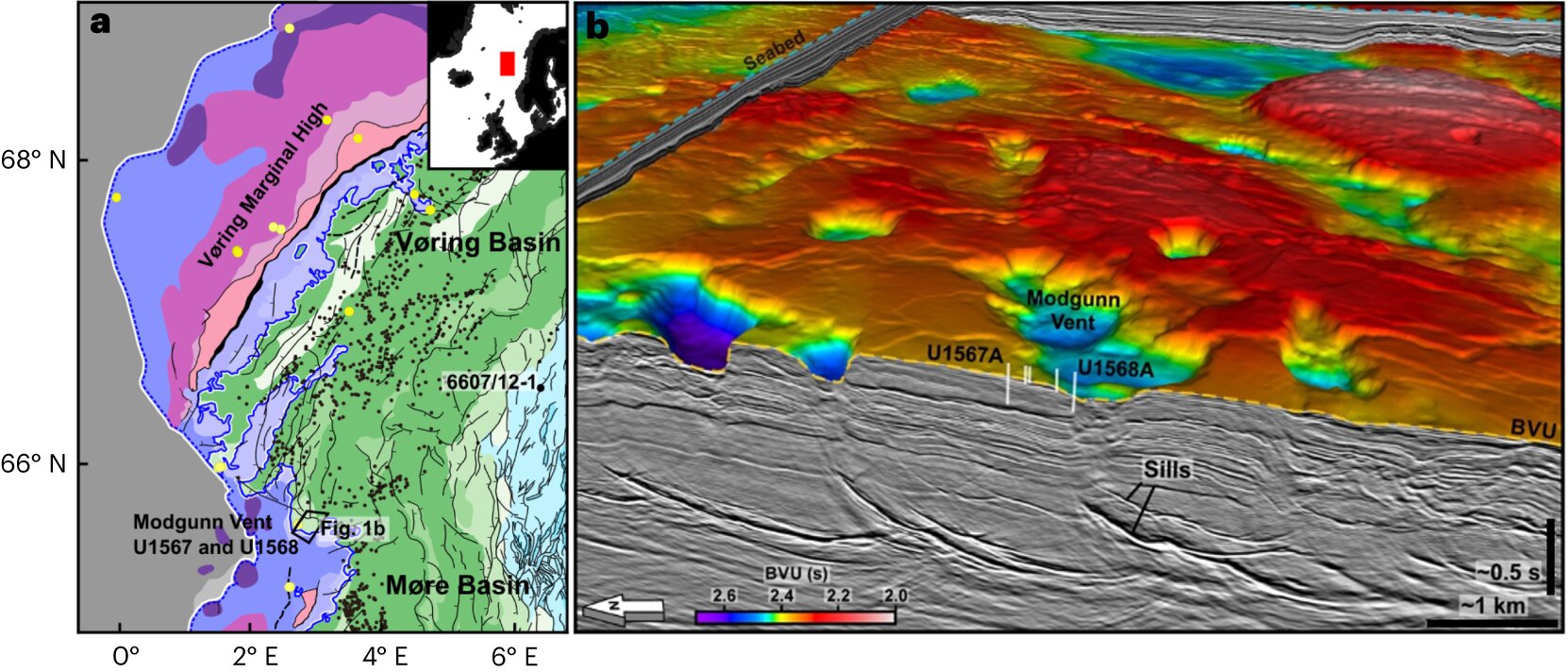HTVCs on the mid-Norwegian margin. a, Structural elements. Purple colors, extrusive volcanic elements related to continental break-up; green colors, Cretaceous basins; black dots, hydrothermal vents; gray, oceanic crust. Yellow dots, Deep Sea Drilling Project, Ocean Drilling Project and Integrated Ocean Discovery Program drill sites. Inset shows location of study area. b, Three-dimensional view of seismic reflection data showing the relationship between volcanic intrusions (sills) and the paleoseafloor depressions formed by the hydrothermal venting. BVU, interpreted Base Vent Unconformity. Industry 3D seismic data courtesy of TGS under a Creative Commons license CC BY 4.0. Credit: Nature Geoscience (2023). DOI: 10.1038/s41561-023-01246-8
About 55 million years ago, the Atlantic Ocean was formed as the continents of Europe and America began to separate. This separation caused the Earth’s crust to rupture, leading to the release of large amounts of magma. This volcanic activity created large igneous provinces (LIPs) in various locations worldwide. One such LIP formed between Greenland and Europe and is now submerged several kilometers below the ocean’s surface. A team of international researchers, led by Christian Berndt from the GEOMAR Helmholtz Center for Ocean Research and Sverre Planke from the University of Oslo, has conducted an extensive drilling campaign in this LIP and has now analyzed the collected samples. In their recently published study in Nature Geoscience, the researchers have discovered evidence of hydrothermal vents that were active at very shallow depths or even above sea level. This suggests that significantly larger amounts of greenhouse gases could have been released into the atmosphere during this time compared to previous estimates.
“During the Paleocene-Eocene boundary, some of the most powerful volcanic eruptions in Earth’s history occurred over a span of more than a million years,” explains Christian Berndt. According to current understanding, this volcanic activity caused a significant global warming of at least 5°C and led to a mass extinction event known as the Paleocene-Eocene Thermal Maximum (PETM). Geologists have been puzzled by the fact that most modern volcanic eruptions actually result in cooling due to the release of aerosols into the stratosphere. The discovery of numerous hydrothermal vents associated with magmatic intrusions in the Karoo large igneous province in South Africa has led to the hypothesis that substantial amounts of greenhouse gases, such as carbon dioxide and methane, might have been released into the atmosphere through hydrothermal venting.
“When our Norwegian colleagues Henrik Svensen and Sverre Planke published their results in 2004, we were eager to conduct further investigations by drilling into the ancient vent systems in the North Atlantic,” says Christian Berndt. However, the necessary technology for riser drilling was not available at that time, which posed a challenge. As research progressed, the team discovered hydrothermal vent systems that could be reached through riserless drilling. With this new opportunity, the drilling proposal was resubmitted, and the expedition finally commenced in the autumn of 2021, 17 years after the initial proposal was submitted. The research cruise, conducted by the International Ocean Discovery Program, involved around 30 scientists from 12 different countries aboard the scientific drilling ship “JOIDES Resolution.” They drilled five boreholes directly into one of the many hydrothermal vents and obtained core samples that provide valuable insights into the Earth’s history.
The results of the study are remarkable. The researchers found evidence that the vent was active just prior to the Paleocene-Eocene Thermal Maximum and that the resulting crater was rapidly filled as global warming began. Surprisingly, the data also revealed that the vent was active in very shallow water, possibly less than 100 meters deep. This has significant implications for our understanding of the climate impact of these vents. Berndt explains, “Most of the methane released from active deep-sea hydrothermal vents today is rapidly converted into carbon dioxide, which is a less potent greenhouse gas. Given that this vent is located in the middle of a rift valley where water depth should be greatest, we can assume that other vents were also in shallow water or even above sea level. This would have allowed much larger amounts of greenhouse gases to enter the atmosphere.”
The core samples obtained from the drilling also provide insights into the climate dynamics during that time. The findings do not support the theory that the global warming during the Paleocene-Eocene Thermal Maximum was caused by the release of gas hydrates—a concern that has gained attention in recent years. However, the samples do indicate that it took many millennia for the climate to cool down again, suggesting that the Earth’s system was able to self-regulate, albeit on timescales that are not relevant to our present climate crisis.
Overall, this study sheds new light on the role of volcanic activity and hydrothermal venting in past climate changes. The discoveries made in the North Atlantic LIP provide valuable insights into the potential impact of such phenomena on the Earth’s climate system. Further research in this field will contribute to our understanding of climate dynamics and help us better prepare for future challenges.
This document is subject to copyright. Apart from any fair dealing for the purpose of private study or research, no part may be reproduced without the written permission. The content is provided for information purposes only.
Denial of responsibility! TechCodex is an automatic aggregator of the all world’s media. In each content, the hyperlink to the primary source is specified. All trademarks belong to their rightful owners, and all materials to their authors. For any complaint, please reach us at – [email protected]. We will take necessary action within 24 hours.

Jessica Irvine is a tech enthusiast specializing in gadgets. From smart home devices to cutting-edge electronics, Jessica explores the world of consumer tech, offering readers comprehensive reviews, hands-on experiences, and expert insights into the coolest and most innovative gadgets on the market.


